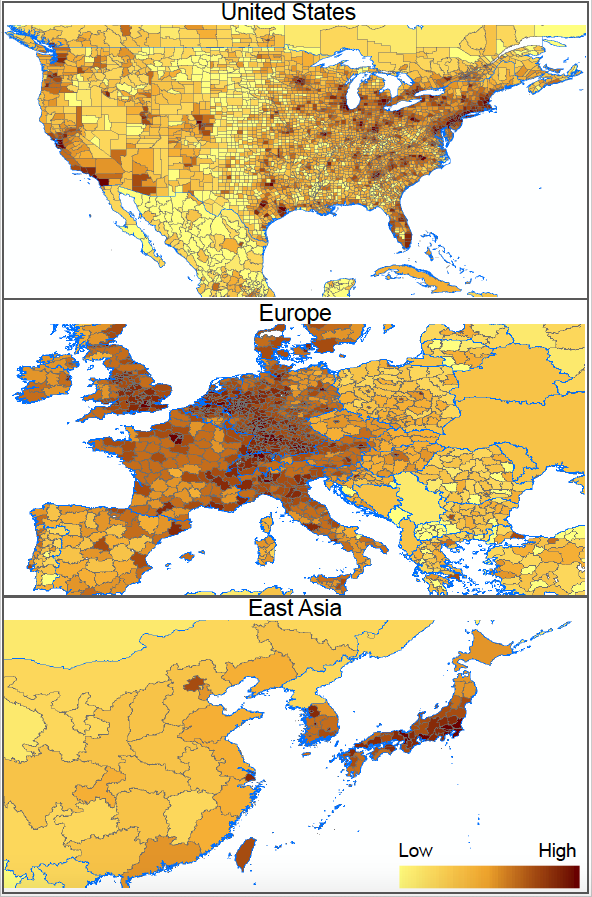Innovative activity in most countries around the globe is concentrated within a few highly productive regions. For instance, hardware and software innovating firms in the US concentrate in Silicon Valley, while in China the innovation technology and high-tech industry is largely located in the Shenzhen area. Petrochemical and pharmaceutical innovating firms in Germany agglomerate in the Rhineland-Pfalz region, while Switzerland hosts most of its firms in that industry around Basel. The presence of innovation clusters, however, is by no means only a sector-specific phenomenon. Across all sectors and all countries around the globe, we observe a large degree of spatial heterogeneity in regional innovative capacity (e.g. Ratanawaraha and Polenske 2007, Feldmann et al. 2010).
In a new study (Egger and Loumeau 2018), we document the heterogeneity in the productivity of innovating, in general, and of patenting specifically, across 5,633 regions around the globe. We discuss sources of this spatial heterogeneity, gaining insights from a global regional model and a long-term economic growth analysis. The model is calibrated such that main regional characteristics – including population density, per-capita income, and market accessibility – match those of the real world in the year 2005. In addition, the model is informed by data on the regional patenting output as well as the innovation-promoting policy environment.
Many national governments employ R&D tax policy instruments to attract innovative activity and therefore stimulate regional growth and gain in international competition. Eventually, this behaviour affects the spatial distribution of innovative activity and leads to important insights regarding the global economic growth path. Previous studies analysing the effect of R&D tax incentives on regional innovation or productivity outputs abstracted from key interdependencies between markets, regions, and outcomes (e.g. Westmore 2013, Baumann et al. 2014, Boesenberg and Egger 2016). However, those spatial interdependencies may add an important layer to the understanding of why innovative activity is distributed as we observe it nowadays and how much R&D policy instruments add to the economic development of a region. We therefore adopt a structural approach that permits accounting for direct as well as indirect (general-equilibrium and spatial spillover) effects.
Why do we see a clustering of innovative activity?
Comparing innovative activity across regions around the globe is commonly done using patent registrations collected in international patent databases (e.g. Griliches 1990, Ratanawaraha and Polenske 2007, Nagaoka et al. 2010). However, not all innovations are patented. In fact, non-patented innovations appear to be much more common than patented ones for several reasons that are discussed in Nagaoka et al. (2010).
We use data on regional characteristics in the context of their multi-regional model framework to extract an innovation-related productivity measure on a global scale, which subsumes the consequences of patented, as well as unpatented, innovations.
Figure 1 illustrates this regional productivity measure by the examples of the US, Europe, and Eastern Asia. The regional borders are delineated according to the classification used by the OECD REGPAT database. The granularity of regions is very fine in countries with a relatively high patenting activity, while it is coarse in those countries with a relatively low patenting activity.
Figure 1 Innovation-related productivity, normalized by region size
The figure suggests that innovation-related productivity is clustered in a few highly productive regions. The measure reproduces innovation hubs like Silicon Valley, special economic zones along the Chinese east coast, or innovation clusters in south-west Germany and northern Switzerland.
Figure 2 Patent stock between 1995-2005, normalised by region size
Figure 2 contrasts this measure to the observable patent count in the same regions, using data on the patent stock between 1995 and 2005 from REGPAT. Clearly, the two figures imply that there is a correlation between these two metrics (the correlation coefficient is 0.64).
Why do we see such a clustering of innovative activity in specific regions? We identify three fundamental reasons:
- exogenous regional amenities and endowments of land,
- the accessibility of the global market through location and the availability of transport infrastructure, and
- the innovation-promoting policy environment of a country a region is located in.
In the context of our economic model, exogenous amenities describe given characteristics of a region that increase its desirability as a place to live in. Being endowed with good amenities helps to attract people (i.e. workers and researchers) at given wages. More people to draw talent from leads to better innovations. In addition, large concentrations of people in, for example, urban areas benefit from agglomeration economies through the diffusion of innovations from elsewhere.
Second, our model proposes that market accessibility is determined by the magnitude of transportation costs and a region’s geographical location relative to the potential customer base. Hence, better market accessibility increases the returns to innovation and favours the formation of innovation clusters through a greater global sales potential.
Finally, the institutional framework in which firms operate determines, at least partially, the level that firms invest in improving local technology. An innovation-promoting policy environment makes researchers more productive and amplifies firms’ returns on investment in R&D, again leading to greater sales.
The innovation-promoting policy environment
To gain in international competitiveness, many national governments employ various kinds of R&D tax instruments, which aim to stimulate innovation output. Commonly known as front-end tax policy incentives, these instruments include tax holidays from firms with R&D investments, R&D-investment-related grants from the government, or any form of deductions of R&D investments from profits. An innovation-promoting policy environment reduces the costs of producing innovations and, hence, attracts highly innovative firms to relocate. In return, regions benefit from hosting highly innovative firms as such firms can offer higher wages and higher land rents to produce and therefore contribute to greater regional well-being.
Where are innovation-promoting policy instruments particularly productive? In regions where amenities are weak and global markets are harder to access. In some sense, a government can promote innovation by helping to shield places against the adverse effects of bad endowments, with amenities or land on the one hand, and of location on the other hand. From an economic policy point of view, R&D investment incentives act as place-based policies, which are commonly adapted to enhance the economic performance of disadvantaged regions.
Long-term positive growth effects
Our study suggests that the promotion of innovation has relatively long-lived positive effects. About one-tenth of the economic growth on the globe can be attributed to the use and implementation of innovation-promoting tax schemes. These effects are particularly strong in regions where innovation-promoting policies are in place. However, regions that are not exposed to such policies nonetheless benefit from them being in place elsewhere, given that improvements in technology dissipate and become publicly available with time. On average, only a relatively small part of the benefits, in terms of real consumption gains, materialises through patenting; to a varying degree across regions, most of the gains are due to unpatented innovations.
References
Baumann, M, B Knoll and N Riedel (2014), “The global effects of R&D tax incentives: Evidence from micro-data”, unpublished manuscript.
Boesenberg, S, and PH Egger (2016), “R&D tax incentives and the emergence and trade of ideas”, Economic Policy 89(32).
Egger, PH, and N Loumeau (2018), “The economic geography of innovation,” CEPR Discussion Paper 13338.
Feldman, MP, and DF Kogler (2010), "Stylized facts in the geography of innovation," Handbook of the Economics of Innovation, vol.1, Elsevier.
Griliches, Z (1990), “Patent statistics as economic indicators: A survey”, Journal of Economic Literature 28(4).
Nagaoka, S, K Motohashi and A Goto (2010), “Patent statistics as an innovation indicator”, in Handbook of Economics of Innovation, vol.2, Elsevier.
Ratanawaraha, A, and K Polenske (2007), “Measuring the geography of innovation: A literature review”, in K Polenske (ed.), The Economic Geography of Innovation, Cambridge, UK: Cambridge University Press.
Westmore, B (2013), “R&D patenting and growth”, OECD Economics Departments Working Papers 1047.





